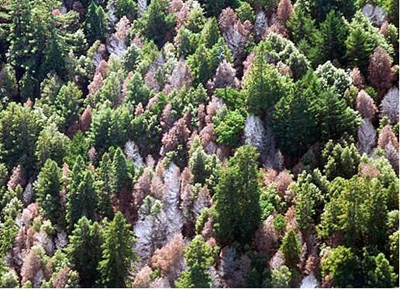|
|
Global Tree Mortality |
 |
The effects of climate change and drought on forest ecosystems are not confined to the southwestern United States alone or even to the world’s arid regions. Other forest ecosystems, which cover some 30% of the world’s land surface, may be responding to climate change already. Examples of climate-induced forest mortality can be found for each of the world’s six wooded continents: Africa, Asia, Australia, Europe, North America, and South and Central America. For example, climate change and variability are reducing tree density and tree species richness in the African Sahel and seasonal droughts have increased background tree mortality rates for tropical forests in South and Central America. As with the Southwest, the increased evidence of global climate-driven tree mortality suggests that world’s forest ecosystems may be vulnerable to warmer temperatures in the future and projected increased droughts. |
Research
-
Adams, H. D., M. Guardiola-Claramonte, G. A. Barron-Gafford, J. Camilo Villegas, D. D. Breshears, C. B. Zou, P. A. Troch, and T. E. Huxman. 2009. Temperature sensitivity of drought-induced tree mortality portends increased regional die-off under global-change-type drought. Proceedings of the National Academy of Science 106: 7063–7066.
-
Allen, C. D. 2009. Climate-induced forest dieback: an escalating global phenomenon? Unasylva 60:43–49.
-
Allen, C. D., A. K. Macalady, H. Chenchouni, D. Bachelet, N. McDowell, M. Vennetier, T. Kitzberger, A. Rigling, D. D. Breshears, E. H. Hogg, P. Gonzalez, R. Fensham, Z. Zhang, J. Castro, N. Demidova, J.-H. Lim, G. Allard, S. W. Running, A. Semerci, and N. Cobb. 2010. A global overview of drought and heat-induced tree mortality reveals emerging climate change risks for forests. Forest Ecology and Management 259(4):660–684.
-
Auclair, A. N. D. 1993. Extreme climatic fluctuations as a cause of forest dieback in the Pacific Rim. Water Air and Soil Pollution 66:207–229.
-
Bigler, C., O. U. Bräker, H. Bugmann, M. Dobbertin, and A. Rigling. 2006. Drought as an inciting mortality factor in Scots pine stands of the Valais, Switzerland. Ecosystems 9:330–343.
-
Condit, R., S. P. Hubbell, and R. B. Foster. 1995. Mortality rates of 205 neotropical tree and shrub species and the impact of a severe drought. Ecological Monographs 65(4):419–439.
-
Gonzalez, P., C. J. Tucker, and H. Sy. 2012. Tree density and species decline in the African Sahel attributable to climate. Journal of Arid Environments 78:55–64.
- Ma, Z., C. Penga, Q. Zhub, H. Chenb, G. Yuc, W. Lib, X. Zhoua, W. Wanga, and W. Zhang. 2012. Regional drought-induced reduction in the biomass carbon sink of Canada’s boreal forests. Proceedings of the National Academy of Sciences of the United States of America 109(7):2423–2427.
-
McDowell, N., W. T. Pockman, C. D. Allen, D. D. Breshears, N. Cobb, T. Kolb, J. Plaut, J. Sperry, A. West, D, G. Williams, and E. A. Yepez. 2008. Mechanisms of plant survival and mortality during drought: why do some plants survive while others succumb to drought? New Phytologist 178:719–739.
-
Peñuelas, J., F. Lloret, and R. Montoya. 2001. Severe drought effects on Mediterranean woody flora in Spain. Forest Science 47:214–218.
-
van Mantgem, P. J., N, L. Stephenson, J. C. Byrne, L. D. Daniels, J. F. Franklin, P. Z. Fulé, M. E. Harmon, A. J. Larson, J. M. Smith, A. H. Taylor, and T. T. Veblen. 2009. Widespread increase of tree mortality rates in the western United States. Science 323:521–524.
-
Williams, A. P., C. D. Allen, C. I. Millar, T. W. Swetnam, J. Michaelsen, C. J. Stilla, and S. W. Leavitt. 2010. Forest responses to increasing aridity and warmth in the southwestern United States. Proceedings of the National Academy of Sciences of the United States of America 107: 21289–21294.
|
|

